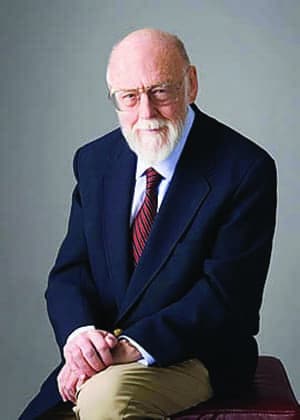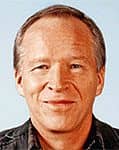Research | March 2019 Hearing Review
Toward differentiation between SNHL, SNHL with cognitive decline, and SNHL with APD
It is well known that a patient’s audiometric configuration does not, and cannot, always describe the true impact of a hearing loss. Sensorineural hearing loss (SNHL) is often accompanied by a decline in cognitive function and/or deficits in central auditory processing. This article shows how the Dichotic Sentence Identification (DSI) Test can help differentiate between simple SNHL and those hearing losses involving cognitive decline or auditory processing disorder (APD) in older adults.
As we grow older, successful listening—especially in noisy environments—becomes ever more challenging. There are three principal causes:
1) Loss in peripheral hearing sensitivity,
2) Decline in overall cognitive function, and
3) Deficit in central auditory processing.
We use the pure-tone audiogram to assess the first factor by measuring pure-tone threshold loss across the audiometric frequency change. The typical signature is a bilaterally-symmetrical sensorineural loss, increasing gradually with frequency. Degree of cognitive decline, especially memory, attention, and speed of mental processing, can be assessed by a number of psychological tests. The third factor, however, decline in the processing of auditory information in areas and pathways of the brain, has remained elusive.
In this article we show how a test assessing dichotic listening might differentiate among simple sensorineural hearing loss (SNHL), SNHL plus cognitive decline, and SNHL plus auditory processing deficit in elderly listeners. Dichotic tests have a long history in the audiological evaluation of elderly persons. Of particular interest is the finding of an abnormally large right-ear advantage (REA), or, more properly, an abnormally large left-ear disadvantage (LED), reported to be associated with auditory processing disorder (APD).1
Dichotic Test Reporting Modes
Dichotic tests can be administered in two reporting modes, free report and directed report. In both modes, two different test items are presented to the two ears simultaneously. In the free report mode, the listener is instructed to report both items in any order. In the directed report mode, the listener is pre-instructed to report only the items heard in one of the two ears. Then the procedure is repeated for the other ear. In the present study we employed the Dichotic Sentence Identification Test (DSI) in both reporting modes.
The Dichotic Sentence Identification (DSI) Test
The speech test materials of the DSI Test are synthetically fashioned sentences, originally constructed by concatenating individual word triplets according to the rules governing third-order approximations to English syntax.2 They are essentially meaningless sentences, but, surprisingly, often resemble reasonable sequences of English words.
One of the principal factors motivating the development of a dichotic sentence test was to diminish the contaminating effect of high-frequency SNHL on the speech recognition performance of elderly persons.Peripherally-based hearing sensitivity loss, a common characteristic of the aging auditory system, is difficult to control as the audiologist seeks to understand the possible cognitive and central auditory dimensions underlying an abnormally large REA/LED. Even a moderate degree of sensorineural hearing loss, especially in the high-frequency range above 1000 Hz, impacts performance on tests like Consonant-Vowel (CV) syllables and Dichotic Digits quite aside from cognitive and/or central auditory processing problems. The DSI test was specifically developed to minimize such peripheral hearing loss confounds. It was purposely designed to be less challenging, and therefore less affected by the high-frequency losses so common in elderly persons.
In the DSI test two different seven-word synthetic sentences are presented simultaneously to the two ears of the listener. Each sentence is chosen at random from a pool of six sentences, originally selected from a larger pool of synthetic seven-word sentences, and carefully matched for duration.
In the actual test a numbered list of the test sentences is placed before the listener. After the presentation of each pair of sentences, the listener must report the number of the sentence or sentences heard. Two procedures are followed: In one, the listener reports the numbers for the sentences heard in each ear (Free Report). In the other, the listener reports only the number of the sentence heard in either the right or the left ear (Directed Report). In all conditions a score is derived separately for each ear, based on the presentation of 30 sentence pairs.
It should be emphasized that, in the DSI test—even in the free-report condition, where two responses are required on each trial—this is not an especially challenging task. Young adults with normal hearing routinely score 100% in all four conditions. In the case of elderly persons, however, scores well below normal limits are sometimes observed. The fact that the DSI Test is a substantially easier task than tests based on consonant-vowel syllables or numbers means that it is less susceptible to the effects of even moderately severe sensorineural loss. Thus an abnormal lowering of the DSI score on a particular test condition can be more readily attributed to cognitive or central auditory processing factors in spite of loss in peripheral sensitivity.
A Retrospective Study
During a short period at the Baylor College of Medicine in Houston and the audiology service of the Methodist Hospital, the Dichotic Sentence Identification (DSI) Test3 was part of the standard audiological evaluation of patients referred to the audiology service. This yielded DSI data on 172 elderly persons in the age range from 60-89 years with varying degrees of SNHL. All had been referred for evaluation of hearing aid candidacy. The results of the analysis of these DSI test data are presented in this report. The data illuminate the complex picture of dichotic listening test results in elderly persons with hearing loss.
What We Found
The raw data analyzed included four DSI scores:
1) Right Ear – Free Report;
2) Left Ear – Free Report;
3) Right Ear – Directed Report;
4) Left Ear – Directed Report.
Significance of abnormality was based on the DSI norms developed by Fifer et al.3After careful scrutiny of each of the 172 individual data sets, we concluded that the four DSI scores of each listener fell into one of three basic patterns. In Pattern I all four DSI scores were within normal limits. A typical example is illustrated in Figure 1. The pure-tone audiogram of this 75-year-old woman showed moderate symmetrical SNHL: Pure tone average (PTA) scores, averaged over frequencies from 500 to 4000 Hz, were 43 dB HTL for the right ear and 45 dB HTL for the left ear. DSI scores for both free-report and directed-report conditions on the right ear were 100%. On the left ear, the score for directed report was 100%, and the score for free report was 93%. Again, scores for all conditions were within normal limits. The 7% difference between right and left ear scores in the free-report condition may be a reflection of the normal right-ear advantage/left-ear disadvantage common to right-handed individuals, but is well within the DSI norms.
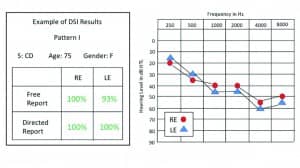
Figure 1. Dichotic DSI test results for both free-report and directed-report modes in a 75-year-old woman with a moderate bilateral sensorineural hearing loss. All four scores were within normal limits. This pattern was observed in 19% of the 172 elderly persons tested. Green scores are within normal limits; red scores are below normal limits.

Figure 2. Dichotic DSI test results for both free-report and directed-report modes in a 74-year-old man with a moderately severe bilateral, high- frequency sensorineural hearing loss. Scores were within normal limits for both modes on the right ear and for the left ear in the directed report mode, but well below normal for the left ear in the free-report mode. This pattern was observed in 58% of the 172 elderly persons tested. Green scores are within normal limits; red scores are below normal limits.
Pattern II (Figure 2) is illustrated in the case of a 74-year-old man with bilateral, steeply sloping symmetrical SNHL. His PTA scores, averaged over frequencies from 500 to 4000 Hz, were 16 dB HTL for the right ear and 20 dB HTL for the left ear. Both right-ear DSI scores (free report and directed report) were 100%, within normal limits. In the case of the two left-ear scores, however, the DSI score was within normal limits for directed report, but, at 60%, fell below the normal limit in the free-report condition. This is an example of Pattern II, characterized by a substantial left-ear deficit in the free-report condition, but normal performance in the directed-report condition.
Pattern III is illustrated in Figure 3 in the case of a 67-year-old woman with a mild, slightly sloping symmetrical loss. PTA scores, averaged over frequencies from 500 to 4000 Hz, were 11 dB HTL for the right ear and 10 dB HTL for the left ear. Both right-ear DSI scores were within normal limits, but both left ear scores were below normal limits: 70% for directed report and 64% in the free-report condition.
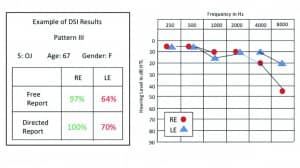
Figure 3. Dichotic DSI test results for both free-report and directed-report modes in a 67-year-old woman with a mild bilateral, sensorineural hearing loss. Scores were within normal limits for both modes on the right ear, but the left ear was abnormally low in both the free-report and directed-report modes This pattern was observed in 23% of the 172 elderly persons tested. Green scores are within normal limits; red scores are below normal limits.
It is noteworthy that, in spite of the substantial peripheral sensitivity losses reflected in the depressed audiometric configurations of the two individuals characteristic of Patterns I and II, DSI scores in the 100% range were observed. Both sets of data illustrate the fact that DSI scores are less compromised by peripheral sensitivity loss than are more difficult dichotic tests.
Interpretation
The prevalence of the three patterns in our elderly cohort is summarized in Figure 4. Nineteen percent (19%) of the cohort yielded results in all four conditions that we interpreted as “Normal.” This prevalence is certainly lower than might be expected in the general population of elderly persons, a finding skewed, perhaps, by the presence of hearing loss sufficient to motivate a search for assistance via hearing aids.
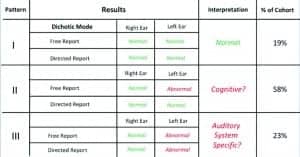
Figure 4. Summary and Interpretation of Dichotic Sentence-Identification (DSI) scores for both free-report and divided-report modes in 172 elderly listeners with sensorineural hearing loss. Green scores are within normal limits; red scores are below normal limits. In this cohort of 172 elderly people, who sought help for hearing loss, approximately 2 in 10 had no difficulty with the DSI task in either the free-report or directed report mode in either ear. Aprroximately 6 in 10 showed a pattern suggestive of a problem in the marshalling of cognitive resources to cope with performance on the left ear in the free-report mode only. Finally, approximately 2 in 10 showed what appeared to be a genuine central auditory processing deficit based on the DSI test result.
More than half of the cohort (58%) reflected Pattern II; within normal limits on both ears in the directed report condition, and within normal limits in the directed-report condition on the right ear, but significantly depressed performance on the left ear in the free-report condition. The left-ear pathways appear to function well in the directed-report condition but not in the free-report condition, suggesting that these individuals may be having some difficulty in marshaling the cognitive resources, especially memory and attention, necessary to deal with the more difficult free-report task.
The fact that this group did well on the left ear in the directed-report mode but not in the free-report mode argues against a genuine left-ear input deficit on an auditory processing basis.
Pattern III, present in 23% of the cohort, suggests a different situation. Here the fact that performance was impaired on the left ear in both the free-report and directed-report modes argues against a strictly cognitive interpretation, since the left-ear deficit in the free-report mode does not disappear when the directed report mode is employed. A more likely explanation would be an aging effect, diminishing the efficient transfer of crossed left-ear input to the language processing site in the left hemisphere via the corpus callosum. Only this result can be properly termed a genuine “auditory-specific processing disorder” on the basis of dichotic testing.
Indirect support for these interpretations is provided by the 2001 paper of Hallgren et al4 In 30 elderly hearing-impaired listeners these authors correlated several cognitive measures (including short-term memory, verbal information processing speed, and phonological processing) with their combined free-report scores (combined ear scores), and with their directed-report scores, separately for both directed-right and directed-left report modes. In their words:
“These cognitive parameters correlate with the results of the dichotic test when focusing to the left, but not when focusing to the right in the directed-report condition. In the free report condition the overall performance [right and left ears combined] showed a high correlation with cognitive test parameters” [p 120].4
These results are in accord with our suggestion that the combination of a deficit in both left free-report and left directed-report scores suggests a structural problem in the auditory processing system. While our left-ear score, in either the left free-report score or the left-directed report score, can be best explained on a cognitive basis, our right-ear directed-report deficit (see above quote) cannot also be thus explained. The fact that both ears show an abnormality in both free-report and directed-report modes argues for an explanation based on an auditory-specific processing deficit in the central auditory system
Parenthetically, young children constitute another cohort whose cognitive skills are not yet fully developed. Is there a possible lesson here for persons pursuing a diagnosis of APD in a child, based largely on dichotic testing? Is it possible that many children, tested only in the free-report mode, have been given the APD label mistakenly?
Take Home Messages:
In a cohort of 172 elderly persons with sensorineural hearing loss:
1) Nineteen percent (19%) did well on both free-report and directed-report dichotic tasks for both right- and left-ear inputs.
2) Fifty-eight percent (58%) did well on both right and left ears in the directed report task, but poorly on the left ear in the same task in the free-report mode. This appeared to be largely a problem in marshaling the necessary cognitive resources to cope with the more difficult task in the free-report mode.
3) Twenty-three percent (23%) did well on the right ear in both the free-report and directed-report modes, but poorly on the left ear in both modes. This appeared to be a problem in relaying the left-ear input to the left-hemisphere linguistic processing site; a result which might reasonably be termed an “auditory-specific processing disorder.”
4) If only the free-report mode is tested in elderly persons, it is not possible to distinguish between cognitive deficit and auditory deficit, since the possibility that the left-ear input will be normal in the directed-report mode has not been explored. There might be a lesson here for those who have used a test of dichotic listening only in the free-report mode as a diagnostic measure of APD in children.
5) If you are going to use only one mode, let it be directed report. But best practice is to test in both modes.
Correspondence can be addressed to HR or James Jerger at: [email protected]
Citation for this article: Jerger J. Dichotic listening in elderly, hearing-impaired persons: An exercise in pattern recognition. Hearing Review. 2019;26(3)[Mar]:18-22.
References
-
Bellis T. Differential diagnosis of (central) auditory processing disorder in older listeners. In: Musiek FE and Chermak GD, eds. Handbook of (Central) Auditory Processing Disorder: Auditory Neuroscience and Diagnosis, Volume 1. San Diego, CA: Plural Publishing;2007:319-345.
-
Speaks C, Jerger J, Jerger S. Performance-intensity characteristics of synthetic sentences. J Speech Hear Res.1966;9(2):305-312.
-
Fifer RC, Jerger JF, Berlin CI, Tobey EA, Campbell JC. Development of a Dichotic Sentence Identification test for hearing-impaired adults. Ear Hear.1983;4(6):300-305.
-
Hällgren M, Larsby B, Lyxell B, Arlinger S. Cognitive effects in dichotic speech testing in elderly persons. Ear Hear. 2001;22(2):120-129.

